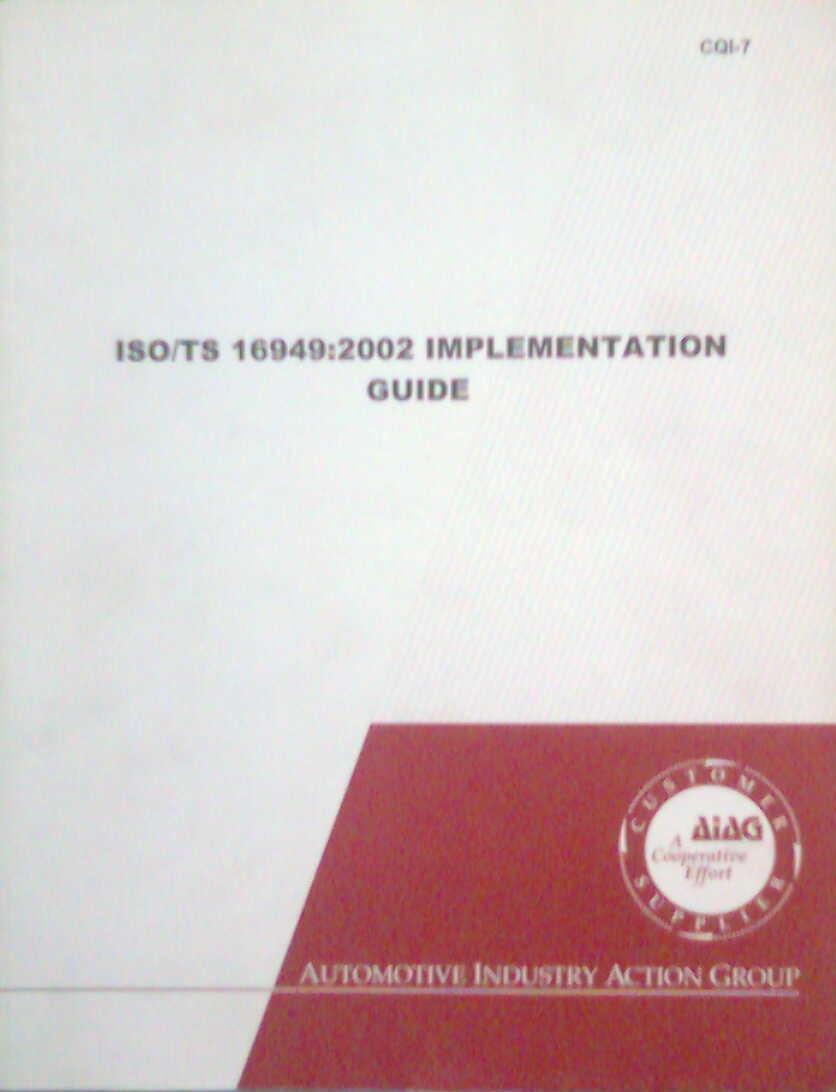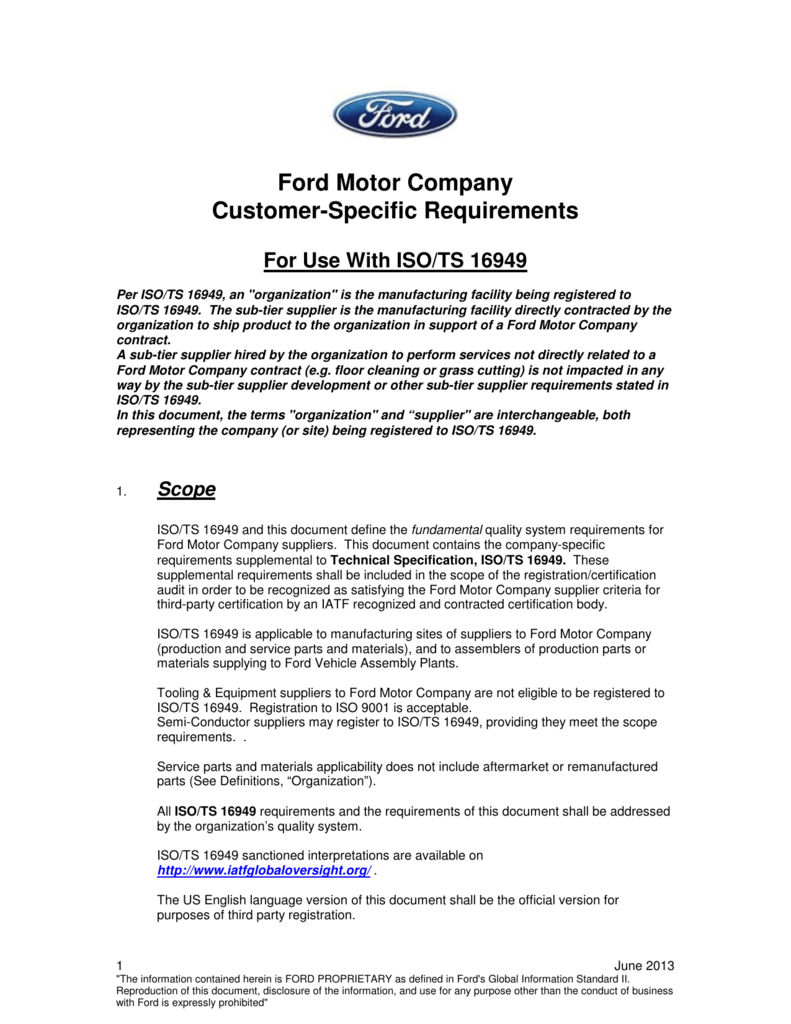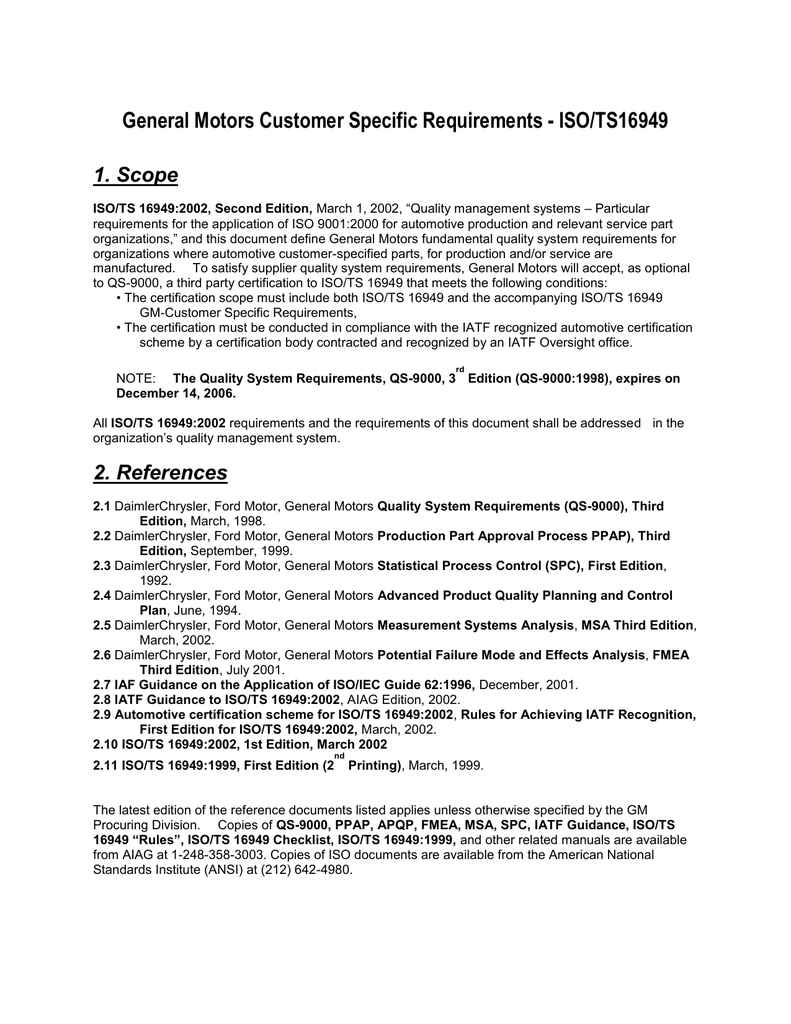Aiag Iso 16949 Manual
AIAG's Quality initiatives span the wide array of product development, manufacturing, service, and customer experience improvement activities to support the manufacturing technology and product innovation advancements that are required from successful and growing suppliers and OEM's. While grounded in the quality standards and core tools that are the foundation of automotive quality excellence, the current AIAG quality initiatives are exploring new issues, providing insights, and the latest tools and methodologies to support the manufacturing technology and product innovation advancements that are required from successful and growing suppliers and OEM's. Recent events have clearly demonstrated the challenges in managing the scope, scale and complexity of today's automotive supply chain. AIAGs materials management, ecommerce and logistics initiatives are far-reaching and can have a significant impact on supply chain efficiency - whether the goal is to improve the flow of information, reduce in-transit damage, speed up the flow of parts through international borders, or provide greater visibility anywhere in the system. AIAG Supply Chain Management initiatives provide guidelines, training and educational opportunities to understand and manage the complexity and scope of supply chain issues.. By being both proactive and collaborative, AIAG brings our members together to develop innovative solutions to these and other common CR challenges, both national and international.
AIAG understands the range of CR issues and laws affecting the automotive and related industries, and we stay on top of changing conditions and expectations. Using this intelligence and our unique position at the nexus of multiple industries and companies, we develop the active insights, trainings and tools our members need to operate responsibly—and profitably. Our corporate responsibility work is guided by a CR Steering Committee, which is facilitated by AIAG and comprised of senior staff volunteers from our member companies, including FCA, Delphi, Ford, General Motors, Honda, Toyota, ZF TRW and many others.
The Committee, along with its Advisory and Working Groups of members and subject matter experts address industry issues in three core issue areas: Social, Economic and Environmental Sustainability.
By Robin O’Connell As anyone who’s experienced the process can attest, implementing a quality standard can be an intimidating task. Certainly ISO/TS, the new quality management system for the automotive industry, seems at first glance as daunting as others of its kind. However, knowing how to address implementation challenges in advance makes achieving a successful management system much more realistic.
Implementation veterans agree that starting the ISO/TS 16949 process early will save unnecessary headaches and costly problems in the future. The International Automotive Task Force designed ISO/TS with smooth implementation in mind. One of IATF’s goals was to improve the implementation process, which had been criticized by many organizations that implemented QS-9000 and ISO/TS.
To assist ISO/TS 16949’s new approach to quality management, the Automotive Industry Action Group published an implementation guide. Developed by a committee of suppliers, automotive manufacturers and certification industry experts, the manual walks readers through the complete implementation process. Delphi Corp.’s Terri Pratt and American Axle and Manufacturing’s Kelli Rogers went through the ISO/TS registration process. They both contributed to the AIAG’s guide and, in doing so, identified five crucial points an organization should master before designing an ISO/TS quality management system.
Step 1: Know the major additions ISO/TS is based on the ISO 9001:2000 quality management system standard. ISO 9001:2000’s approach to quality management is significantly different than that of ISO 9000:1994, the quality standard on which QS-9000 and ISO/TS were based. ISO/TS includes new guidance for automotive suppliers, but ISO 9001:2000 is the central tenet of ISO/TS.
Companies implementing ISO/TS will find ISO 9001:2000’s relevant content highlighted in boxed text. “The single most significant change in 2002’s ISO/TS 16949 is the dramatic increase in customer focus,” Pratt notes.
Significantly more emphasis is placed on customer satisfaction in the latest revision. The IATF, which developed ISO/TS 16949, expects 2002 audits to focus heavily on customer-oriented processes, or COPs. COPs underscore the need for organizations to include customer input as an essential part of meeting customer requirements. “Understanding customer requirements drives not only the COPs but also the measurement and goal of customer satisfaction-both major focuses of ISO/TS audits,” Pratt adds. “By meeting customer requirements, customer satisfaction can be achieved.” Customer satisfaction is accomplished by adding value to the product-realization processes.
These processes include developing, constructing, distributing and managing an organization’s product. There are 15 new or expanded requirements in ISO/TS. Four major differences from previous automotive quality requirements include: Management commitment. Management’s role as a key player in the process is emphasized more in ISO/TS 16949 than it was in QS-9000. Top management has certain responsibilities that it must accept rather than delegate to others. Prepare top managers to become more involved with the registration audits. Customer communication.
At least 50 percent of the audit will focus on customer-specific requirements. Metrics, trends, analysis and improvement are heavily reviewed during audits. Internal auditor qualifications. Focus on customer-specific requirements for auditor qualifications. Step 2: Understand the new approach ISO/TS made a great leap from the 1999 version’s vertical breakdown of the process approach. ISO/TS divided organizations into distinct units-also called the “silo” approach-and assessed each part as a separate entity. This didn’t account for the sequence and interaction of their processes.
“The process approach is horizontal,” Rogers says. “A process is a set of interrelated or interacting activities that transform inputs to outputs. It considers the entire system and its linkages. The process approach can look at the links within an organization and confirm that they’re functioning or if there’s a disconnect.
Determining disconnects opens opportunities for improvement not previously recognized under QS-9000 or ISO/TS.” Determining what customers require will help an organization develop its quality management system. The figure on page 25 illustrates how customer requirements are applied to each step of a product’s life cycle.
The final output should result in customer satisfaction. The process approach begins and ends with the customer.
“Jumping from an elemental approach to the process approach is a challenge,” Pratt admits. “The key isn’t just containing problems discovered while implementing and auditing ISO/TS 16949, which may be a temporary fix, but also addressing daily business with the links in mind.” Step 3: Measure up An organization’s measurement techniques are also highlighted for review during ISO/TS 16949 audits. Does the organization understand the measurements? Do they make sense? Correctly selecting what business elements to measure and how to approach that process will lead to greater customer satisfaction. “Avoid frequently used measurements that don’t provide useful feedback,” Rogers recommends. “Instead, choose measurements that apply to the individual characteristics of the organization.
The goal is to communicate productive information with the results and provide a baseline for continual improvement. Auditors will have an idea of areas to measure, but internal management knows best what will be most telling for the company.” Frank Lomas, BSI’s technical certification manager, was another member of the team that put together the AIAG’s implementation guide. “Customer rating and customer complaint measurements are a good place to start when looking to assess internal results,” he says. “Customer complaint responses are particularly useful for tracking efficiency and effectiveness, the ultimate objectives of ISO/TS 16949.” Align organizational activities to the measurements most important to the customer. Using customer feedback captured by pertinent measurements will help ensure that the customer’s perspective is central to the management system’s objectives. Measurement on the manufacturing floor is done in a variety of ways, but measuring a process in an office environment can be more difficult. Carefully scrutinize potential measurements.
Are they the right ones? Do you need to create a new measurement, or does one naturally lead to another? Be sure to align measurements with the objectives of the process approach. Step 4: Be efficient and effective “The great thing about ISO/TS 16949 is that it was developed with an aim of getting away from the compliance that grew out of QS-9000,” Lomas emphasizes. “The assessments are focused on improving efficiency and effectiveness.” Unlike QS-9000, ISO/TS 16949 goes beyond basic compliance and seeks organizational efficiency and effectiveness from quality management systems.
Effectiveness is determined by assessing the system’s outputs in relation to its inputs, comparing process outputs to the organization’s objectives and analyzing the measurements used to track progress. If measurements aren’t telling the right story, they must be reconsidered. The quality management system’s effectiveness will be extensively reviewed during audits. The ability to show examples of business tracking and striving for continual improvement will also be expected. Meeting expectations might satisfy certification requirements, but a little extra thought and effort can provide additional bottom-line savings and overall business improvement. “This is a common-sense standard,” says Pratt.
Aiag Iso 16949 Manual
“If you have an ‘implement and forget it’ attitude, you’ll miss the point and the benefits that ISO/TS 16949 can provide.” Being both effective and efficient creates a common language between the customer and the organization. For example, a company might be effective in producing a quality product due to containment efforts, and customer ratings might show this. But at the same time, the process to achieve these results might not be efficient because of the extra personnel needed to sort the product. “Efforts to achieve balance go hand in hand with continual improvement,” Lomas explains. “ISO/TS 16949’s flexibility allows audits to tailor to individual organizations-they don’t have to fit the same model to accomplish company goals.” Step 5: Avoid pitfalls “Learn from other companies’ pitfalls,” advises Rogers.
“Others have already gone through the process of upgrading and have encountered situations that should be avoided. Knowing these situations ahead of time is a great way to start.” Techniques for avoiding the common pitfalls of each stage of implementation follow. Before the audit Select a registrar. Not all registrars accredited to register companies to QS-9000 are qualified to register to ISO/TS 16949. Delphi and American Axle used BSI Management Systems to register more than 50 sites. Delphi consolidated 35 sites to a single “corporate” registration.

American Axle upgraded 11 facilities to ISO/TS with 11 unique registrations. Switch registrars if needed. If you decide to change from your QS-9000 registrar, you’ll not be able to receive a discount on personnel-days for your upgrade. Have customer-specific requirements.
Many automotive manufacturers have developed certain documented requirements. Note that several OEMs and tier-one customers have likewise composed customer-specific requirements of their own. “Obtain copies of all requirements before registration and plan accordingly,” Lomas stresses. “Too often these are overlooked, and the certification process is delayed.” Ensure the timeliness of registration. OEMs won’t be sympathetic to suppliers that miss the required registration date. Organizations should plan well in advance for their transition. Remember, there are significantly fewer accredited registrars and auditors available to perform ISO/TS 16949 services than there are for ISO 9001 services.

Schedule multiple sites. When several sites are involved in a company’s registration, it’s advisable that the sites with the supporting processes be audited first. During multiple site registrations, auditing the supporting processes during the earlier stages of registration allows the audit team to adequately assess the interactions among all the sites. The manufacturing site can’t receive registration until the support sites have been audited.
Know the auditor. ISO/TS 16949 has certain requirements for third-party auditors, including prior experience in the organization’s field. Being familiar with an auditor’s background can assist the organization in determining the auditor’s areas and level of expertise. Requesting a biography or other information from new auditors for review is common. During the audit Management responsibility.
Management should play a supportive and directive role in an organization’s quality management system. A show of management support and direction for ISO/TS 16949 is required. Competence, awareness and training. ISO/TS 16949 training requirement goes beyond QS-9000 requirements.
Not only must the organization show that it has trained its employees appropriately, but it must also show that employees are competent at their jobs. “Employees must be aware of their effect on the quality objectives and goals of the organization,” Rogers says. “Auditors will seek proof that employee competence requirements are in place and actively followed.” After the audit Act quickly.
A follow-up of any major or minor nonconformances found by the registrar should be addressed quickly, with any necessary corrective actions planned and organized immediately. During the initial audit, if a major or minor nonconformance is issued, the registrar will inform the organization of the time required for submitting a corrective action. Ready to begin?

Auditors are on the lookout for organizations that try to sell their developed ISO/TS 16949 plans but don’t practice them on a daily basis. Management must not only understand the management system in place but must also continually participate in its upkeep. As automotive supplier deadlines approach in 2004 and beyond, getting a jump-start on ISO/TS 16949 planning is a wise move. Audits will focus on activities and objectives most important to customer satisfaction. Begin by understanding the process approach and then practice it daily. “Step back and see your management system as a whole,” Rogers recommends. “Use common sense, and take advantage of the standard to improve your business.” About the author Robin O’Connell is head of public relations for BSI Management Systems in the Americas.
Contact O’Connell by calling (703) 464-1903, or visit.